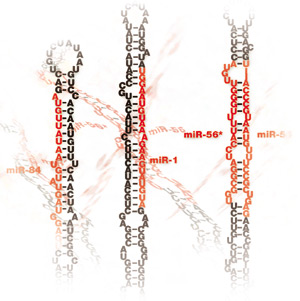The art of simplicity is a puzzle of complexity. ~ Douglas Horton
It is a whispering metaphor like the curling smoke from a
snuffed candle, lazy, aromatic and constantly evolving, this thought about
genes and cancer. Yet the burnt wick and the ethereal smoke are real.
Back in 1948 a quiet man by the name of Claude Shannon and another by the name of Ralph Hartley arrived at a law for
Information Theory that would hold
Moore's Law hostage. they opined that communicating information would reach a
limit because of two things; bandwidth and the Gaussian noise. By noise they meant distortion in its simplest terms. But bandwidth, now that was a surprise.
While Moore had suggested the doubling of storage capacity of a computer chip every 18 months
without limits, the funneling of that data was through
"narrow conduits." In other words it would be the
"bottleneck" that would limit idea dispersion and not the density of
ideas.
Kurzweil's extended dimensions of the Moore's Law
And now we seem to be finding the same bottleneck in Genetics.
Humans have a library of about 22,333 functional genes, this culled down from its ancient reminder that there were supposedly 100,000 of these on, off switches that make us, humans twitch.
Everyday there is a new
discovery of "this gene mutation leads to that." If one goes combing
the various pathways within a single cell that get turned on and off on the whims
of one, two or a multitude of genes, the computational algorithms become
monumental.
Furthering the dilemma is the interaction of the epigenetic
influence via the microRNAs adds another layer of complexity to an already
challenging incoherency in knowledge. And adding to that is the whole other "jumping gene" or "transposons" that hop around to find more diversity and a"fitter" state of being.
The intricate web of the miRNA
We are left with so many triggers that it
boggles the mind. I believe that is why Barbie of Ken's flame, famously said,
"Math is difficult, let's go shopping."
Now before we go exploring this further, let me suggest a
metaphor that will help simplify a very complex web of interactions.
Imagine if you will, a car. It is made out of many, many parts, like the
sterling wheel, which, too has many different parts. But the beauty is that the
combined efforts of all these parts, works.
VW disassembled parts
You get in the car, turn the key or
press a button and voila the engine comes alive. You shift the transmission to
"Drive" and presto, you are on our way. Not forgetting that the
engine itself is composed of many parts too, like the pistons, valves,
combustion cylinders, spark plugs etc. And the you press the accelerator and
with the flow of fuel into the cylinders, ignited by the spark from the plugs a
combustion occurs that push the cylinders, that move the drive-train and the
car goes in motion. Okay now that you have the concept, just imagine a few
issues that might arise; if the radio doesn't work, it doesn't hamper the drive
but the entertainment, if the horn doesn't work, the car still moves but there
s a potential for an accident, if the power window doesn't work, well too bad, especially on a hot day, however if the starter didn't work the entire car would be useless and if the
brake failed while the accelerator got stuck, then you would have a potentially bad day.
Okay now let's translate that into the genetic business. As
mentioned there are several triggers that can create mischief in the human body
but some of them are just a nuisance and not necessarily disaster, for example;
a very wise scientist named Koch discovered that a single allelic (gene
homologue on opposite arms of same chromosome) mutation of the RB gene does not
create a disease. It does however weaken the defense against disease should
some environmental shard of wrath come hurling out of nowhere and damage the
remaining allele (like, an errant gamma ray of cosmic radiation).
Proving Koch's Postulate
So, what with all these shenanigans that the genes conspire, or
are conspired upon, what exactly happens? The genes have both accelerators and
brakes. As long as the brake-pads are not worn out , as happens with old age or
with chronic immune deficiency state, the system works well. The brake-pads prevent a runaway scenario. Genes switch the
circuit breakers on for accelerated growth as need by the tissue due to damage,
replacement etc, the signal sifts through a maze of parallel intertwined
pathways to arrive at the nucleus (the cell center). Here the resulting signal
brings with it gobs of protein (the required building blocks ~ like Lego
blocks) to create two from one. Once the proliferative mechanism is in place
the cell divides and creates two identical daughter cells. After the feed-back
loop mechanism signals back the lack of further need, the genes are notified
and they either stop sending the signal for further multiplication or send the
antagonistic signal to shut down the growth process, in other words apply the
"brakes."
In cancer, however the accelerator mechanism can get stuck and
thus override the brakes, the brakes may fail or both work and the cancer moves
along slowly, surreptitiously at a timid but competent pace. In cancer, the accelerator
mechanism is propagated by the "Oncogenes" while the brake
mechanism is activated by the "Tumor Suppressor" genes.
It is quite obvious that there are very, very few diseases
(cancer not one of them) that one gene disruption causes the one disease for that gene or one bad gene = one disease. Considering that, it would be therefore impossible to known
the many switches that exist for most cancers. Therefore it would be difficult
to target them simultaneously and even if we were to do so, we wouldn't know
the unintended consequences of messing with all those genes to the human body in its totality.
Medicine therefore has taken a different tack; why not attack
the pathways that the genes trigger? A noble thought, wouldn't you say?
Well... And you knew this was coming...
I had mentioned that most pathways are parallel and arching with
sprouting interconnections in between so these synapses of activity go to and
from and back and forth between the various pathways. If one gets jammed, the
other takes over. In cancer the latest venture as I mentioned is to target
these pathways, but what we are finding is the ingenuity of signal transduction
within the cell. If you block one pathway, the cancer slows down, goes into a
temporary remission, even regresses to an unobservable entity, only to take
wings and rise again. So what do we do? Attack some or a combination of
pathways? or even all of them? Should we for instance hit them all concurrently
or sequentially and if so in what sequence? There lies the conundrum, yet to be
solved. But you see normal cells need the pathways too, to continue for their
function and shutting them down will cause a problem for them too and in turn
us, hence the deepening, disquieting dilemma.
One more thing to ponder then, while we are at it. Is it of
great import to know your genome and will it serve the purpose of forewarning
and fore arming against disease? Since genes cannot predict outcomes with 100%
probability, the chaos in the mind would be up for grabs.
However selective
genetic knowledge for example knowing the BRCA I & II can potentially be
life-saving for an individual who can mitigate the crisis with prophylactic
bilateral mastectomies (breast removal) and oopherectomy (ovary removal). Maybe
in the future we will be able to transfect the body with wild-type BRCA tumor
suppressor genes via viral vectors, or use microRNAs to silence the mutated versions,
that would obviate the need for radical surgeries. Now there's a thought!
Hope, human thought and ingenuity spring eternal!
Kinase pathways
Remember, I began with Shannon? The plethora of genetic
signaling triggers get bottlenecked at the known limited pathways within
the cells. The triggers are many, but the paths are few and it will take an
awful lot of hypothesis testing to use the right set of tools to enable some
and disable others in this verity.
From time immemorial, man has desired to comprehend the complexity of nature in terms of as few elementary concepts as possible. ~ Abdus Salam





















































